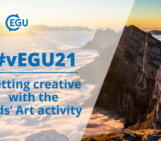
Do you remember a time when everyone else around you started laughing, but you didn’t notice a joke? By designing presentations that are inaccessible – either in PICO, poster or oral presentation format – sometimes people in your audience have this experience of feeling left out.
Last month we posted our top 10 tips for making a presentation ‘accessible’ following the announcement that EGU would be adopting measures to support hearing accessibility during the General Assembly. But these tips were tailored towards audio accessibility, and a number of our followers asked us to add visual accessibility pointers to our list as well! So this month we have produced a sequel: ‘Top 10 tips for visually accessible presenting’ – and we are changing the name of our first list to the more accurate ‘Top 10 tips for audio accessible presenting’ to reflect the difference.
Therefore to help improve the accessibility of all General Assembly presentations, please read our ‘Top 10 tips for visually accessible presenting at EGU’:
- Be careful of colour choices – for many people colour is difficult to read, so try to avoid relying on colour alone to show differences in your diagrams by using textures and icons, too. One of the best ways to check if your colours are distinct is to convert your image into greyscale – is there enough contrast that you can tell the difference?
- Colour contrast isn’t a one-size-fits-all – let’s be honest, one-size-fits-all never works for everyone! Like pullovers, different styles of colour contrast work for different people. For some people a dark background with light text is easier to process; for others it’s a light background with dark text. The best thing to do is to make a plain version of your presentation in the other style (light or dark background) and let your audience know it is available online or that they can request it from you.
- End of the rainbow – rainbow scales are not good ways to communicate for a number of reasons, they are difficult to read for some people because of the reliance on graded colour and research has shown that they lead people to incorrectly interpret data.
- Keep your font simple and clean – whilst we all enjoy a good throwback moment, mid-90’s fonts are not the best way to satisfy an urge to return to that era. Script or handwritten fonts can be difficult to interpret (sans serif fonts are best, like Arial or Verdana) as is text in all capitals, which can come across as shouting at your audience. Make sure you keep both the size and style of font consistent and legible across your presentation.
- Slide transitions should stay in the past – similarly to dated fonts, those fancy slide transition effects should be left behind, as they can trigger nausea, headaches and dizziness in your audience.
- Flashing images can trigger epilepsy – many people are aware that flashing lights can trigger epilepsy, but did you know that high-speed flashing or repetitive images can do the same thing? They are also very distracting.
- Text at the bottom of the page may be blocked – most presentation spaces are not designed just for presenting, so like at the cinema or theatre, there is a good chance that anything at the bottom of your slide/poster will be obstructed by the audience.
- Always describe your images – having images in your slides is a good idea, but make sure you choose them consciously. They should be logical, relevant to your text and help you make your point. Describing the image you show will also help your audience understand how it connects to your idea.
- Think minimalist for your visuals – in presenting, minimalism is best. Like with fonts, your visuals should be simple and clean. If you must share a complicated graph, then it should be the only one in your presentation or on your poster, and you should expect to spend three times the length of time on that slide as your other slides.
- Sharing is caring – if you are able, it always helps your audience if you share your slides or poster afterwards, including with notes if necessary to fill in any gaps.
If you want to contribute your own “Top 10” list on any aspect of accessible presenting at a scientific conference, please get in touch with our Communications Officer at communications@egu.eu.
This year EGU is taking additional steps to continue to improve the accessibility and inclusivity of its annual General Assembly. During the next few weeks we will be regularly posting information about the measures the Union is taking, tips and tricks for meeting attendees, and personal stories and advice from people with various experiences who have attended in previous years.
We are aware that this only represents the first step toward making our conference accessible to all, so if you have any ideas or advice for us on how to improve accessibility at the General Assembly, please tell us about them – we are willing to learn and keen to improve.
If you have a suggestion please email: communications@egu.eu or send us a message on social media.



